European Hedgehog Diet & Feeding Behaviour - Diet Composition
In Hedgehogs, Reeve describes the hedgehog's diet as "catholic and flexible", explaining that:
"In the two European species [europaeus and concolor], all relevant studies have revealed a dynamic, constantly changing balance of prey in the diet".
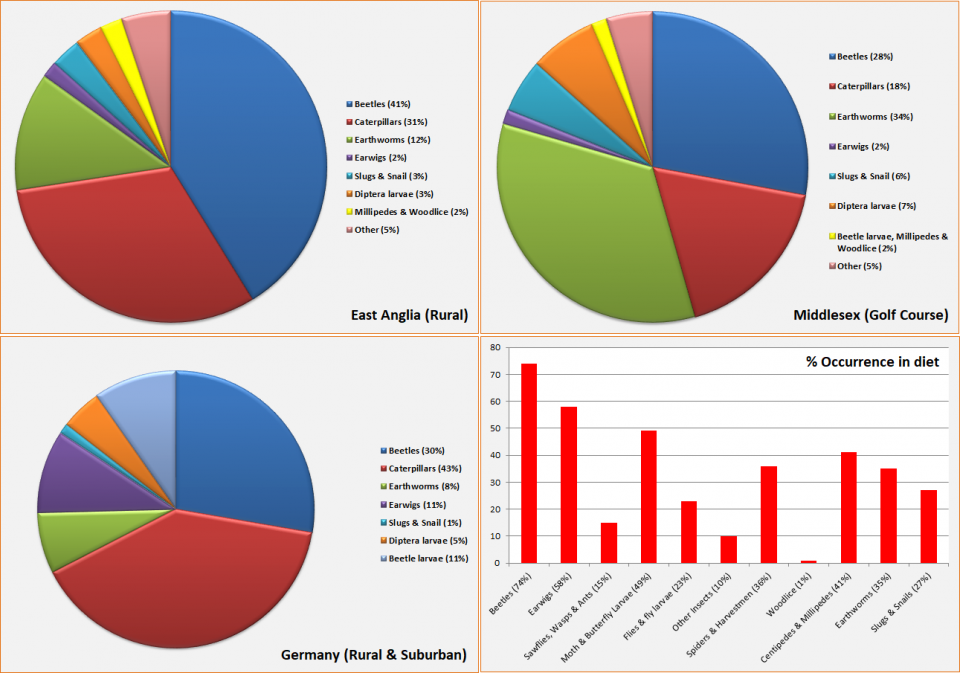
This is well illustrated when we consider the variety of prey consumed.
Invertebrates
According to local availability and season, adult beetles, earwigs (Forficula auricularia, in the UK) and earthworms (largely Lumbricus rubellus) seem to form the bulk of the diet by volume, representing between 80% and 90% according to various dietetic studies, despite the former two groups contributing little to the overall energy budget. In The New Hedgehog Book, Pat Morris describes how one study of the stomach contents from 137 hedgehogs found beetles in 75% of them and earwigs in more than half. In his field note to The Naturalist in 1976, Colin Howes presented his detailed analysis of three hedgehog droppings collected from a garden in Doncaster between July and September. Based on the number of pincers retrieved, Howes calculated that one dropping contained the remains of 32 earwigs (Forficula auricularia) and another the remains of 15. Indeed, hedgehogs seem to specialise in beetles and, in The Complete Hedgehog, Les Stocker notes that even while feeding on carrion, hedgehogs will still pause to snap up a beetle.
Beetles, especially ground beetles (carabids) are commonly found among stomach contents -- black clock (Pterostichus madidus) are the most frequently encountered, although others including Harpalus, Nebria, Amara and Bembidion are listed by Reeve. The dung and chafer beetles (scarabaeids) are also eaten with varying frequency, with the cockchafers (Melolontha) taken in vast quantities. In his 1965 book Hedgehogs, Konrad Herter notes that hedgehogs can feed on poisonous oil beetles and the 'Spanish fly' (Lytta vesicatoria) with no apparent ill effects. Weevils (Curculionoidea) have been recorded in stomach contents, as have ladybirds (Adalia), although some authors suggest hedgehogs generally avoid the latter.
Caterpillars, and to a lesser extent butterflies, moths and skippers (collectively, the Lepidoptera) are often eaten, contributing 26% of the stomach's wet weight contents in some samples. Earthworms are important prey, although, as mentioned earlier, their frequency varies seasonally and can only be taken in any significant numbers when weather conditions are sufficiently wet for the worms to surface. During his Ph.D. studies, Wroot found that earthworms contributed about 35% to the total energy intake of his hedgehogs, with chaetae (the bristles covering the earthworm's body that help them move) recovered from 95% of scats collected.
Molluscs feature to a varying extent on the menu and are usually taken from September onward when other prey is scarce. Slugs and snails, and probably also their eggs, are predominantly the molluscs taken, although the 1972 issue of Nature in Wales contained a short description of a hedgehog seen crunching a swan mussel (Anodonta cygnea), still in its shell, near the shore at Llyn Coron in Anglesey during June of the previous year. Some individuals may consume a substantial number of molluscs and there are reports of hedgehogs rolling large slugs on the ground, presumably to remove the slime (see video below) before eating them piecemeal. This rolling behaviour is apparently innate and is seen in very young hedgehogs feeding on slugs. Where snails are taken, they tend also to be small individuals, the shells of which can be easily broken by the hedgehog's relatively weak jaws (e.g., in this video of a juvenile hedgehog eating snail), although I have seen footage of a hedgehog removing a larger snail from its shell. Analysis of the stomachs of 108 hedgehogs by Derek Yalden suggested only small slugs were taken in any quantity (see QA) and it must be remembered that molluscs can carry a lungworm parasite that can be potentially fatal to hedgehogs.
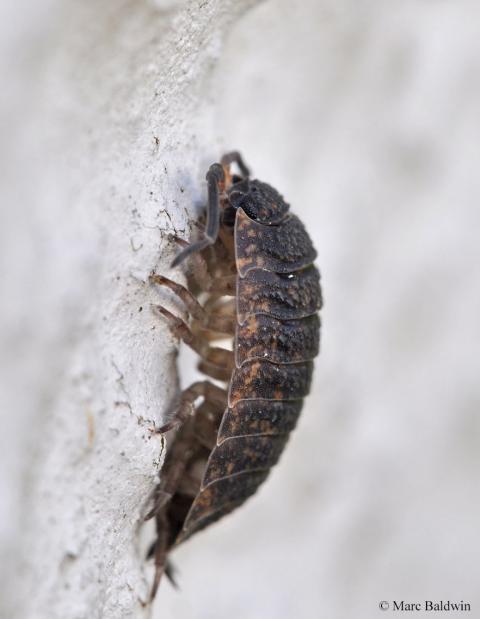
Woodlice are rare components of the diet, with the apparent exception of the pill bug, Armadillidium, which has poorly developed odour-producing lateral plate glands and was readily accepted during Dimelow's food preference studies. Interestingly, if it's the distasteful secretions produced by their lateral plate and uropod glands that deters hedgehogs from eating woodlice, they might be more interested in young woodlice. In 1956, in a paper to the Proceedings of the Zoological Society of London, H. Gorvett at Bristol University suggested the glands of juvenile woodlice may be inactive. Grasshoppers (Orthoptera) and small 'bugs' such as aphids are seldom eaten, although Nigel Reeve cites one observation of aphid eggs in scat.
Bees and wasps (collectively the Hymenoptera) are sometimes taken and, despite a few observations of hedgehogs raiding hives and attacking live bees, the majority are probably taken when moribund or dead. Flies, especially larvae and pupae, are occasionally eaten. Centipedes are rarely taken, presumably because they move fast and bite, while millipedes are a common dietary component probably because of its layer of subchitinous fat. Small spiders, thrips (Thysanoptera), mites and nematodes all feature on the hedgehog's menu, but they are rare and there is some speculation that they, especially the latter two groups, may be ingested incidentally. A stomach analysis of 615 hedgehogs in New Zealand's upper Waitaki Basin found sheathed-wing beetles to be the most common prey item, followed by butterflies and moths and earwigs -- spiders and worms were less common, contributing 8% and 3% respectively.
Vertebrates
Mammals, birds, reptiles and amphibians have all been recorded in the diet of hedgehogs, although it's unclear how much comes from actively-hunted prey and how much consumed as carrion. Indeed, hedgehogs are opportunistic feeders and won't turn down a "free lunch" if the circumstance arises. A lovely example of this was a photo by Peter Al-Sheikhi that appeared on page 209 of the 2009 Norfolk Bird & Mammal Report, which showed a juvenile hedgehog feeding on the carcass of a Grey squirrel killed by a cat in a garden in Thetford. In 2017, Julie Stribley stumbled across a hedgehog eating a dead mouse in Rotherham. I have also seen unconfirmed reports on social media of a hedgehog eating a dead mouse left on the patio by a householder's cat and one the picked up and "ran off with" a greater spotted woodpecker chick killed and dropped by a sparrowhawk. One householder shared a trailcam video showing a hog eating a very young nestling it found dead in their garden in May 2021.
We know that hedgehogs will sometimes tackle live vertebrate prey, although it remains unclear how often this happens. There are several reports of this predatory behaviour on birds that we'll come to shortly. In Hedgehogs, Nigel Reeve recounts the observations of Robert Brockie who witnessed hedgehogs killing and eating green and golden bell frogs (Litoria aurea) in New Zealand. In the UK, Barry Hornsey observed a hedgehog dragging a toad down his road in London during August 2017, although from the photograph Barry posted to The Bees Knees UK Community Facebook group, the toad looks to have been clipped by a car. I'm also aware of an unconfirmed report from Northamptonshire that described a hog "in hot pursuit of a frog" in someone's garden. Similarly, in 2012, a friend of mine in Glasgow watched a hedgehog apparently hunting a house mouse in his garden (see QA).
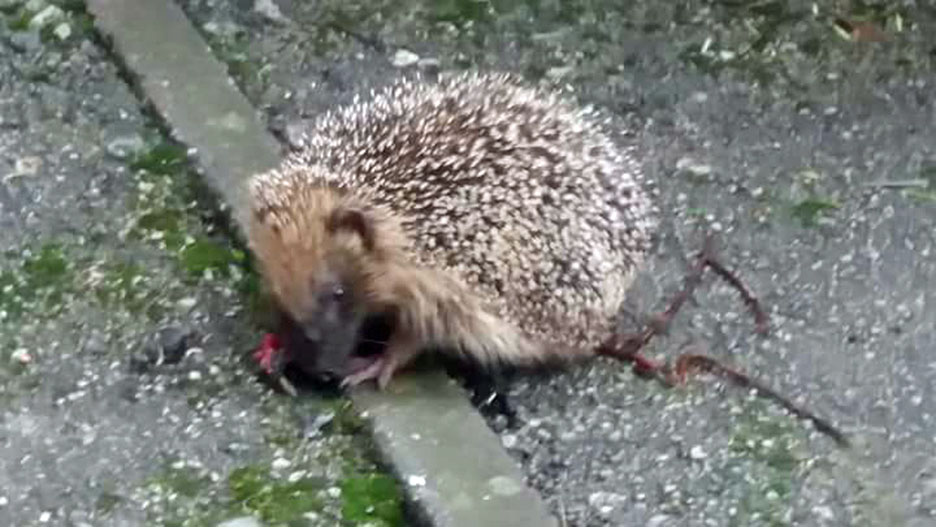
Stomach analysis by Manchester University's Derek Yalden published in 1976 found remains of shrews, mice (considered to be a field mouse, Apodemus), moles, voles and rabbit; their comparative rarity in the diet suggested they may have been taken as carrion. Nonetheless, in their 1958 book, The Observer's Book of Wild Animals of the British Isles, however, W.J. Stoke and Maurice Burton wrote of the hedgehog:
"By depressing its spines it may even find its way between the bars of a hen coop, but after eating a great part of the hen it may be too portly to get out, and then falls victim to the enraged poultry farmer."
Stoke and Burton go on to talk about hedgehogs having a reputation for catching rabbits, too, but note that they're not fast enough to run one down, unless it was sick or injured. In his book Curiosities of Natural History, published in 1903, Francis Buckland described an incident where a gamekeeper stumbled across a hedgehog with a young hare (called leverets) after tracking down a "terrible squeaking". Buckland wrote:
"On turning over the long grass and brambles that overhung the ditch, he found a leveret about the size of a rat, in the jaws of a hedgehog, palpitating in the struggle of death."
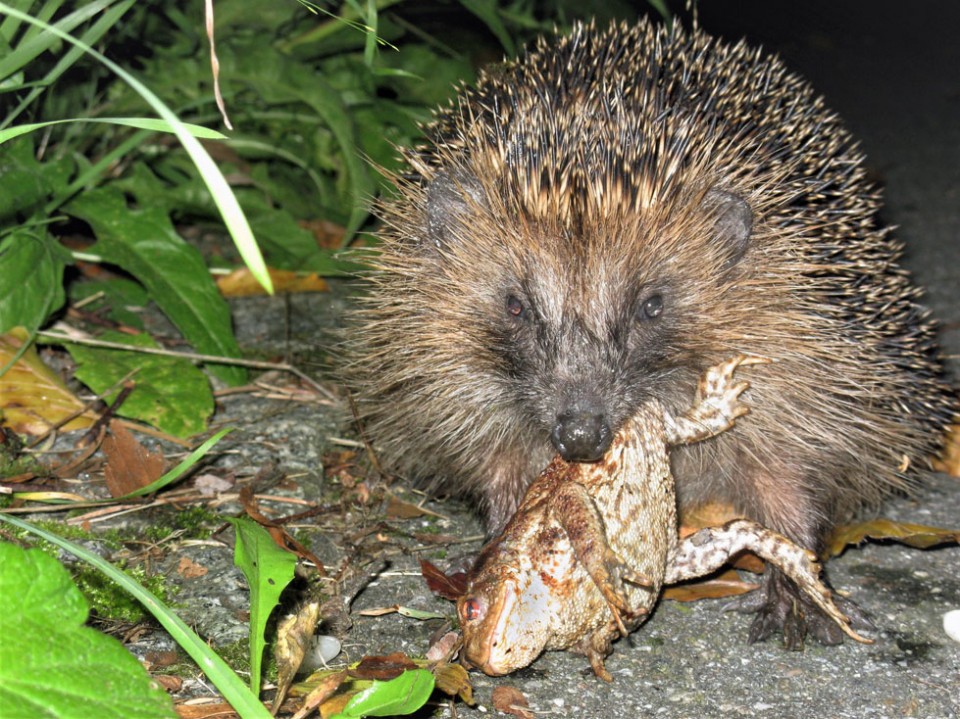
Additionally, in Wild Animals of Britain, Oliver Pike wrote:
"If a hedgehog can find its way into a colony of rats, it will do valuable work in getting rid of these pests. That great Nature lover, Lord Lilford, tells how hedgehogs destroyed a whole colony of rats in a garden."
In his New Hedgehog Book, Pat Morris suggests that most reports of hedgehogs predating mammals and birds are of dubious authenticity and should be treated with caution, many probably reflecting a hedgehog's habit of scavenging carrion where available. We cannot ignore, however, that there appears to be growing evidence that hedgehogs are not afraid of tackling birds and mammals, and many hedgehog carers have expressed to me how feisty and aggressive some individuals can be. If proof were needed of hedgehog pugnacity, it is surely the video of a hedgehog repeatedly biting a brown bear in a zoo.
Finally, on the subject of mammals, there are some reports of cannibalism among hedgehogs. In a letter to an early issue of the Field, a Mr Francis wrote:
"Upon two occasions [hedgehogs] in my possession killed and ate one of their number; and on the second occasion the individual killed and devoured was fully two-thirds grown, and as large as any of the family, excepting the old one. In one night there was nothing left of him but the bare skin and prickles."
Nonetheless, in Hedgehogs, Nigel Reeve urges caution:
"Although it is quite possible that hedgehogs could, under certain captive conditions, kill and eat each other, it seems more likely that many of the cases of so-called 'cannibalism', both in captivity and the wild, are really the result of feeding on the corpses of hedgehogs that have died from other causes. In Brockie's study, one exceptional dropping contained 500 spines! These had been pulled out by the roots, indicating that a rotting hedgehog carcass had been consumed."
There are reports in the literature of hedgehogs taking young ducks, chickens, turkeys and pheasants. Maurice Burton, in his book The Hedgehog, for example, recalls a letter sent to him by a lady in Hull in 1963 who described going to pick up a well-grown pullet from a lane near her house after hearing distress calls only to find a half-grown hedgehog clinging to its breast. There have been a few letters to Bye-gones: relating to Wales and the border counties, a general interest periodical, of hedgehogs feeding on poultry, two of which were published in April 1902. The first, from Thos Ruddy in Corwen, recounted the "suspicious case" of finding a domestic hen dead in its coop with "most of the soft parts of its stomach eaten away". A trap setup next to the dead hen caught a large hedgehog the following day. Ruddy went on to recount how chickens in a lady's garden apparently disappeared and, again, the only creature caught in the trap was an adult male hedgehog; after its death "the chickens lived in peace". In the second account, published the following week, Mr H. E. Forrest described:
"Last summer I met in Monmouthshire a gentleman who had up to quite recently had an estate in the south of Scotland, on which he reared pheasants on a large scale. ... he told me that he had twice had hen-pheasants killed on the nest by hedgehogs who ate into their entrails, and in one instance he actually caught the hedgehog in the act!"
I have come across a couple of reports of hedgehogs having been found eating birds in gardens. In one case, Wildlife Online reader Veronica Henderson told me she found the rotting remains of what appeared to be a blackbird in an occupied hedgehog box in her garden near Saint-Omer in France in August 2017. (This is interesting both from the aspect of a bird being eaten by a hedgehog and being found in a nest, given that hedgehogs are not typically known to remove or cache food.) Similarly, Hans Kruuk's work at the Ravenglass sand dunes in Cumbria in the early 60s recorded hedgehogs predating juvenile black-headed gulls (Chroicocephalus ridibundus); immobilizing the unfortunate bird by sitting on it before starting to eat it from the rear end forwards. In the 23rd October 1901 issue of the aforementioned Bye-gones periodical, Forrest also made mention of a pair of storm petrels (Hydrobates pelagicus) rescued near Llandudno in Wales during the previous week that were killed and eaten by tame hedgehog kept by the hotelier who tried to rehabilitate them.
I have seen trailcam footage of a hedgehog eating a fledgling blackbird or thrush. The video was recorded by Paul Wright in his garden in Winsford, Cheshire during May 2017 and shows an adult hedgehog stumbling across the fledgling that had been brought into the garden by a stray cat at about 2am. The hog sniffs the fledgling for about ten seconds before pinning it down with its front left paw and lurching onto it. The video is only a minute long and does not show the hedgehog fully consuming the fledgling, but it does show the hog repeatedly biting and licking the unfortunate bird. I've also come across a report of a householder, roused by a commotion among blackbird fledglings in their garden, who found a hedgehog with one dead in its mouth and, in July 2020, a hedgehog was found asleep in a blackbird nest amid shell remains, having apparently eaten the eggs. More recently, in late May 2022, the BBC Springwatch team captured what appeared to be a female hedgehog predating two skylark chicks from a nest at Wild Ken Hill in Norfolk. The pouncing and biting behaviour in Paul Wright's video and seen in the Springwatch footage is the same as that described by Russian zoologist Sergej Ognev, during 1962, in hedgehogs encountering frogs or dead birds.
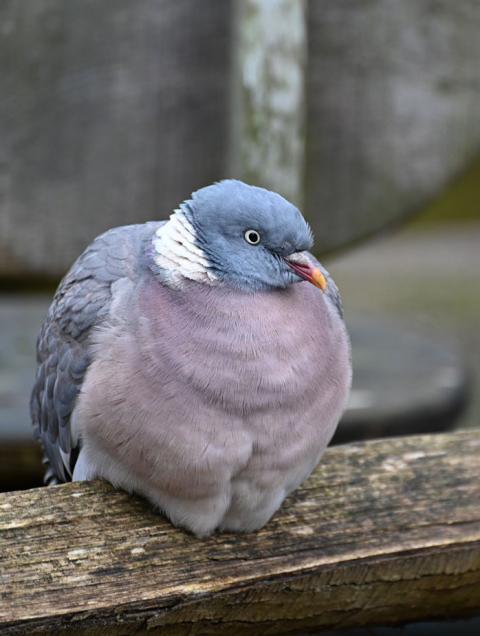
Perhaps the most striking footage I have seen is a video of an adult hedgehog killing and eating a green woodpecker and one seizing and carrying away a fully-grown pigeon in Poland. Indeed, this is now the second report I have come across of a hedgehog tackling a live pigeon. In May 2020, David Gant got in touch after he and his colleague Maureen came across a hog "dragging a fully grown live pigeon across the road" on a residential road in Nottinghamshire at about 1 AM. David told me:
"My car approaching didn't stop it from what it was doing. My work colleague and I just sat staring in shock! We got out and walked up to it and it finally moved away to the side of the road. I managed to pick the pigeon up and move it to the opposite side of the road and noticed it had no feathers on its back between its wings but other than that it was perfectly fine - I wish I had thought of filming it."
We don't know where the hedgehog acquired its prize, although it seems likely the unfortunate bird had been stunned, possibly having been hit by a car earlier in the evening. David also commented on the amazing strength of the hedgehog, who was winning against a bird of equivalent size fighting against it. Apparently "when the hedgehog moved on, it had a mouth full of feathers".
The eggs of birds are taken on occasion, and as a result of taking both eggs and chicks hedgehogs have been implicated in contributing to the decline of ground-nesting birds (see QA).
Snakes are occasionally tackled (see Feeding Folklore), as are lizards and some other reptiles. In their study on the diet of hedgehogs in the wetland and braided riverbed sites of New Zealand's upper Waitaki Basin, Chris Jones, Kristen Moss and Mark Saunders found native lizard (mainly skink, Oligosoma spp.) remains in the guts of 37 (6%) of the 615 stomachs they analysed; the bulk of these hogs were females, which the authors suggest may relate to the higher energetic demands of females during the breeding season. Additionally, hedgehogs will take fish if the opportunity presents and Cumbrian naturalist John Martin told me that he observed a hedgehog strip a brown trout bait, leaving only the skin and bones, after accidentally being caught in a mink trap.
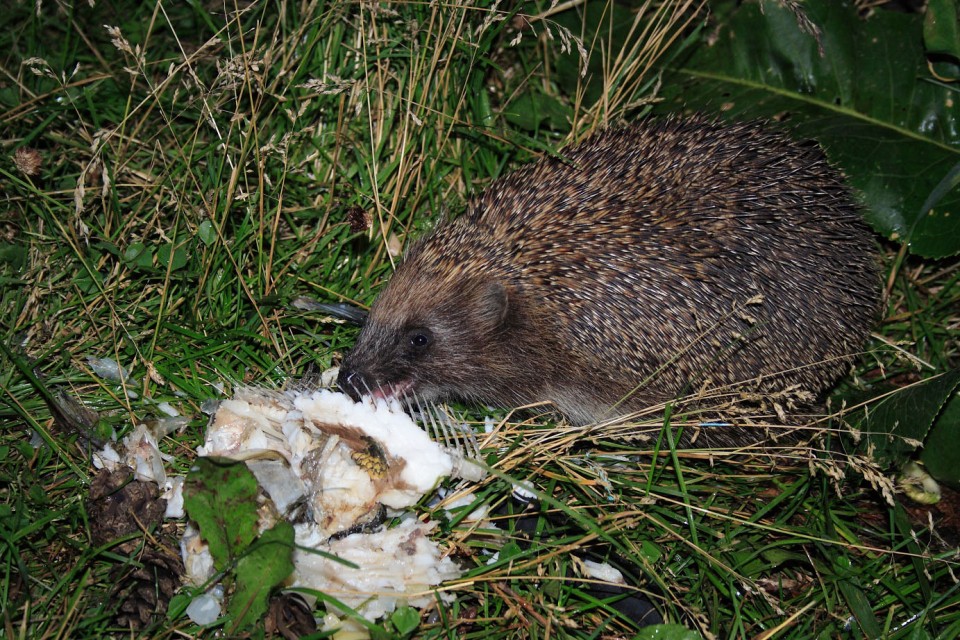
Finally, there is an anecdotal report in a letter to The Countryman by Josephine Swinscow that described how a hedgehog walked slowly past a large marrow-bone left under a tree by her spaniel before stopping, sniffing the air, turning around and going back to investigate. According to Swinscow, the hog circled the bone several times before steadying it with a paw and "chewing away for several minutes with good appetite" while her spaniel looked on "astonished and affronted".
Vegetation & fruit
Some authors have described hedgehogs actively eating plant material, such as clover leaves and plant buds. Moss, conifer needles, bark fragments, fibrous roots and straw, and the seeds and leaves of various plants have also been found among stomach contents. Among the stomach contents of New Zealand's hedgehogs, from the New Zealand Journal of Ecology study referenced above, Chris Jones and his colleagues found grass, flower petals, leaves and seeds, including those of the sweet briar (Rosa rubiginosa). Hedgehogs have also been observed eating seed and other scraps that have fallen from garden bird tables and feeders.
According to Reeve, however, no study has ever reported the digestion, or even the chewing, of plant remains, implying that most vegetation is probably taken incidentally. Nonetheless, several reports suggest that fruit and berries may be taken deliberately and fruit seeds are sometimes recovered from droppings, which suggests intentional consumption. I have seen a video of a hedgehog eating a strawberry and there are reports of hedgehogs having been somewhat worse-for-wear after consuming fermented fruit in their garden. In one such example on the Isle of Wight, consumption of wind-fallen apples and pears is believed to have caused a drunk-like behaviour in the hedgehogs (see QA). It is nonetheless possible that the initial attraction was to insects feeding on the fruit and the fruit/ethanol itself was taken incidentally.
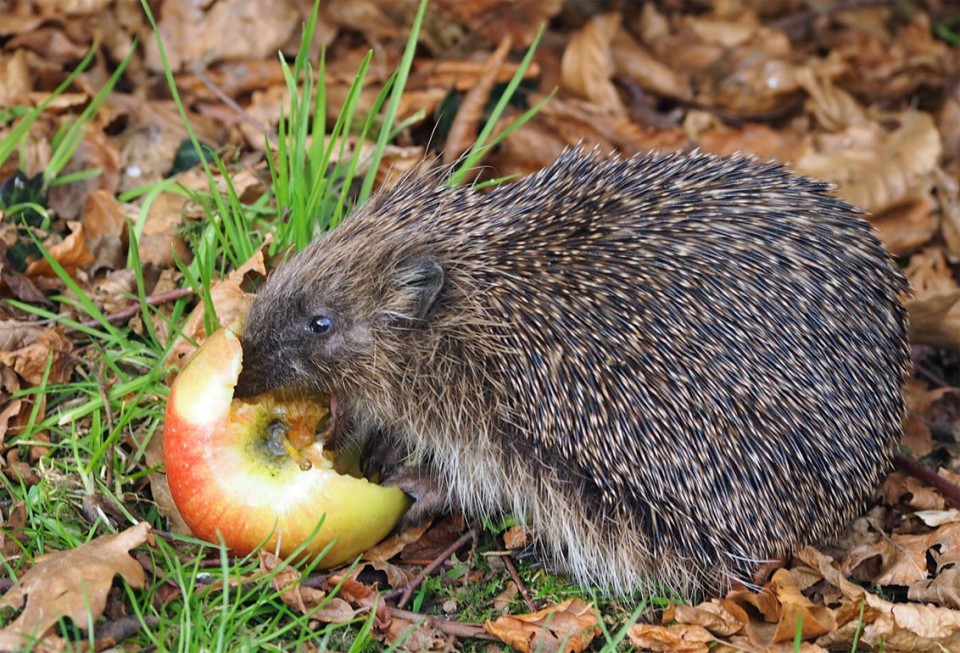
Whether taken deliberately or incidentally, working in the León province of north-west Spain, Ángel Hernández at the University of Valladolid found that hedgehogs were a potential disperser of cherry seeds. Hernández only dissected five hedgehog droppings, but three of these contained cherry seeds. Overall, 54 seeds were recovered (an average of 18 per dropping), all intact, and Hernández noted that the mammal droppings in general were found in locations very suitable for cherry seed germination.
Hedgehogs, it would appear, are not averse to consuming the odd inedible item. In his book, Hedgehogs, Nigel Reeve cites examples of hogs found with plastic, paper and even cotton wool in their stomachs.
Feeding behaviour
Hedgehog feeding behaviour tends to be short, darting movements to snap up prey while foraging. Hogs have nonetheless developed some specific techniques for dealing with otherwise tricky prey items. Most people who have encountered slugs in their garden can testify that they're...well...slimy! As fascinating as slug mucus may be (there are two types that, at the molecular level, represent highly-organised and exceptionally hygroscopic polymeric substances), the thick mucus produced by the pedal gland of the foot represents a defensive mechanism and can be distasteful to predators; its thickness also hampers the physicality of eating the slug.
Hedgehogs presented with slugs have been observed to roll them on the ground to remove the mucus before eating them. Sometimes hogs may get overzealous in their attempts to tackle large slugs -- a report from a rescue centre in 2009 described a hedgehog brought in with a very large slug lodged in its throat that had to be removed with tweezers. (See: Q&A - Do hedgehogs eat slugs and snails? for more on this subject.)